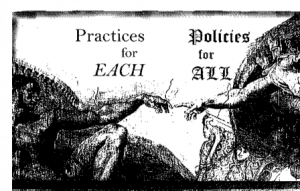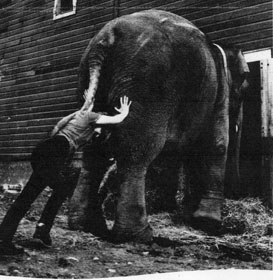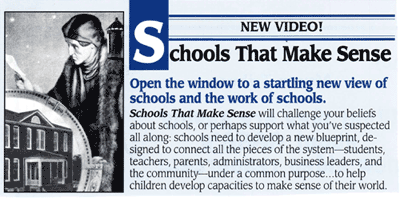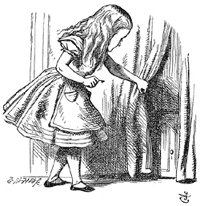Part II: Sharing the Pain
The 1st Root Cause: The Quantum Paradox
(see New Understanding: The Complementarity of Policy and Practice),
While the characterization of the paradox’s nature as “Quantum” comes from science, the situation, as the modified Sistine Chapel metaphor, below, suggests shows up earlier.
It’s a tension that, over the ages, has been “felt” more than understood. That may be why we find it more easily expressed through metaphors and art such as the story of the “Blind Men and the Elephant;” or the Forest and Trees metaphor. In more recent times, Quantum Physicists introduced us to another example — the “wave-particle” duality of matter.
Light, for example, has properties of both particles and waves, which can lead to use of two different models to study and make sense of it as one or the other. Which one is used to frame understanding usually depends on the purposes and tools of the observer. Unfortunately, that makes it difficult to get a handle on its actual both-at-the-same-time nature.
Nevertheless, if the task is to harness the power of light, that actual both/and nature has to be tapped. To do that, however, it first has to be acknowledged, and this can be difficult for those of us accustomed to the benefits of simple answers found within either/or mindsets.
- As the above Sistine ceiling metaphorically suggests, organizational behavior, too, has this Quantum dual property condition. Tangibly, we find the effects of this perceptual disability surfacing regularly in the pendulum swings between “centralization” and “decentralization” in organizations. And in education today it is at the root of the battles for “control” of urban schools districts, and the drive for curriculum standards and testing for All without dealing with their effects on instructional processes for Each.
- To find out whether we may be like physicists before Quantum theory, we might ask:
Do our “models” for understanding schooling focus either on the organizational “wave” or on actions of individual people – “particles?”
Do we see a school system’s behavior as a “sum” of individual actions, or a “product” that is the systemic consequence of all of them together?
Do we have a way to think about them together in terms of their both/and condition in reality? (See New Understanding: A needed Role map) That needed way-of-thinking is addressed on this site by the “lens” we’ve called Alice’s Looking Glass. (Welcome Alice!) One relevant leadership insight offered by its both/and dual perspective is the “simple rule:”
The success of the “wave” is a product of the natural “potentials” already embedded in each “particle.”
Actually I like the Forest and Trees metaphor for this condition better than quantum physics’ particles and waves because it deals with a living system of living systems. (Maybe that’s why I’m personally enamored with the Sufi Elephant fable that captures so well the parts/whole organization-seeing dilemma in its final lines –
“…And so these men of Indostan disputed loud and long.
Each in his own opinion exceeding stiff and strong.
Though each was partly in the right…
they all were in the wrong.”
Peter Senge grasped the nature of this perceptual paradox when he noted that “when we try to ‘step back far enough to ‘see the forest for the trees”’…most of us unfortunately just see “lots of trees.” But then, in “The Art of Seeing the Forest and the Trees,” he suggested how to deal with the condition in ways that also might be used to characterize this site’s approach to what’s been called the seeming everything’s-connected-to-everything-else nature of schooling:
“…the art lies in seeing through the complexity to the underlying structures generating change.
…it means organizing complexity into a coherent story that illuminates the cause of problems and how they can be remedied in enduring ways. …
What we most need are ways to know what is important and what is not important, what variables to focus on and which to pay less attention to.”
That’s why this site’s approach to untangling and “organizing complexity” offers a core level of knowledge that focuses on the forests’ and trees’ common “root”…an X-Factor – the common “underlying structures generating change” that are already embedded in the brain. (see Part III: Sharing the Pain)
Posted: July 7th, 2009 under Understanding the System.
Comments: none








